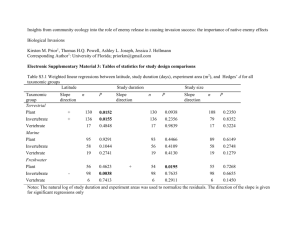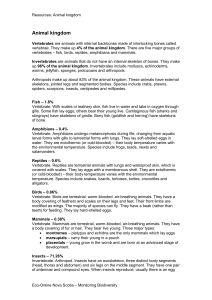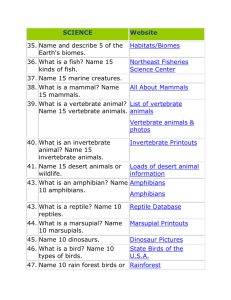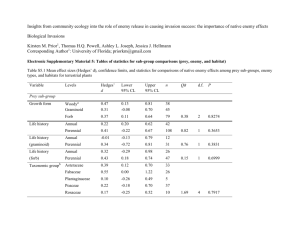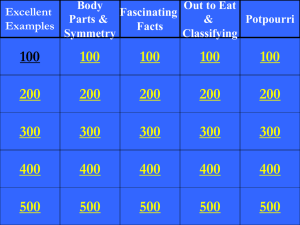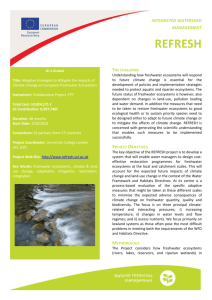Insights from community ecology into the role of enemy release in
advertisement
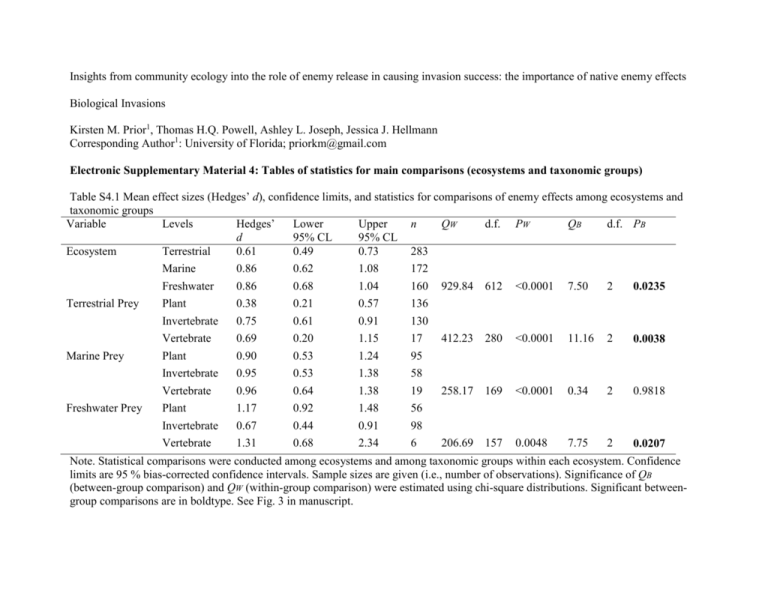
Insights from community ecology into the role of enemy release in causing invasion success: the importance of native enemy effects Biological Invasions Kirsten M. Prior1, Thomas H.Q. Powell, Ashley L. Joseph, Jessica J. Hellmann Corresponding Author1: University of Florida; priorkm@gmail.com Electronic Supplementary Material 4: Tables of statistics for main comparisons (ecosystems and taxonomic groups) Table S4.1 Mean effect sizes (Hedges’ d), confidence limits, and statistics for comparisons of enemy effects among ecosystems and taxonomic groups Variable Levels Hedges’ Lower Upper n QW d.f. PW QB d.f. PB d 95% CL 95% CL Ecosystem Terrestrial 0.61 0.49 0.73 283 Marine 0.86 0.62 1.08 172 Freshwater 0.86 0.68 1.04 160 929.84 612 <0.0001 7.50 2 0.0235 Terrestrial Prey Plant 0.38 0.21 0.57 136 Marine Prey Freshwater Prey Invertebrate Vertebrate Plant Invertebrate Vertebrate Plant Invertebrate 0.75 0.69 0.90 0.95 0.96 1.17 0.67 0.61 0.20 0.53 0.53 0.64 0.92 0.44 0.91 1.15 1.24 1.38 1.38 1.48 0.91 130 17 95 58 19 56 98 Vertebrate 1.31 0.68 2.34 6 412.23 280 <0.0001 11.16 2 0.0038 258.17 169 <0.0001 0.34 2 0.9818 206.69 157 0.0048 7.75 2 0.0207 Note. Statistical comparisons were conducted among ecosystems and among taxonomic groups within each ecosystem. Confidence limits are 95 % bias-corrected confidence intervals. Sample sizes are given (i.e., number of observations). Significance of QB (between-group comparison) and QW (within-group comparison) were estimated using chi-square distributions. Significant betweengroup comparisons are in boldtype. See Fig. 3 in manuscript. Table S4.2 Mean effect sizes (ln R), confidence limits, and statistics for comparisons of enemy effects among ecosystems types and taxonomic groups Variable Levels ln R Lower Upper n QW d.f. PW QB d.f. PB 95% CL 95% CL Ecosystem Terrestrial 0.40 0.32 0.47 276 Marine 0.67 0.51 0.82 162 Freshwater 0.58 0.45 0.73 154 1023.89 589 <0.0001 20.37 2 <0.0001 Terrestrial Prey Plant 0.25 0.13 0.38 128 Invertebrate Vertebrate Marine Prey Plant Invertebrate Vertebrate Freshwater Prey Plant Invertebrate Vertebrate 0.51 0.51 0.74 0.65 0.57 0.83 0.42 0.41 0.22 0.49 0.40 0.38 0.65 0.28 0.61 0.81 0.97 0.92 0.80 1.05 0.60 131 17 87 57 18 52 96 1.35 0.54 2.31 6 413.61 273 <0.0001 16.11 2 0.0003 234.76 159 0.0001 0.70 2 0.7043 333.66 151 <0.0001 25.74 2 <0.0001 Note. Statistical comparisons were conducted among ecosystems types and taxonomic groups within each ecosystem. Confidence limits are 95 % bias-corrected confidence intervals. Sample sizes are given (i.e., number of observations). Significance of QB and QW were estimated using chi-square distributions. Significant between-group comparisons are in boldtype. Table S4.3 Mean effect sizes (Hedges’ d), confidence limits, and statistics for comparisons of enemy effects among ecosystems and taxonomic groups at the study level Variable Levels Hedges’ Lower Upper N QW d.f. PW QB d.f. PB d 95% CL 95% CL Ecosystem Terrestrial 0.65 0.49 0.83 77 Marine 0.97 0.73 1.23 50 Freshwater 1.05 0.84 1.29 47 205.58 171 0.0356 7.19 2 0.0275 Terrestrial Prey Plant 0.54 0.30 0.81 34 Invertebrate Vertebrate Marine Prey Plant Invertebrate Vertebrate Freshwater Prey Plant Invertebrate 0.73 0.89 0.95 1.02 1.20 1.30 0.78 0.50 0.27 0.63 0.61 0.76 0.96 0.54 0.99 1.50 1.29 1.77 1.78 1.72 1.04 33 10 30 13 7 23 20 88.18 74 0.1248 1.61 2 0.4481 63.13 47 0.8651 0.29 2 0.8651 44.42 41 0.3297 4.38 1 0.0363 Note. Statistical comparisons were conducted among ecosystems types and taxonomic groups within each ecosystem. Confidence limits are 95 % bias-corrected confidence intervals. Sample sizes are given (i.e., number of studies). Significance of QB and QW were estimated using chi-square distributions. Significant between-group comparisons are in boldtype. Freshwater vertebrates studies were not included in the analysis because this group contained less than five studies.
